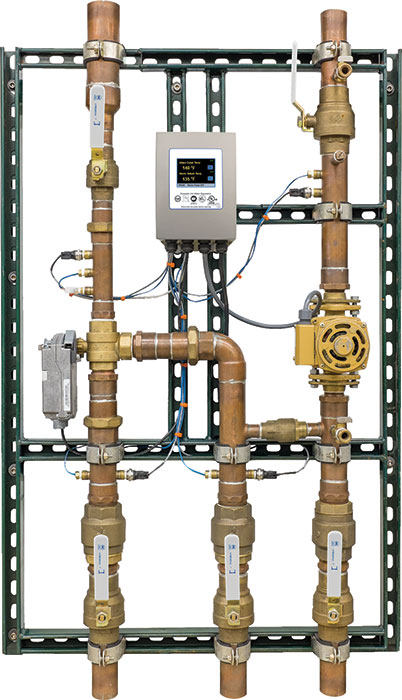Smarter, Safer Hot Water: Digital Thermostatic Mixing Stations
Green Building Ratings And Water Delivery Systems
Many green building rating systems focus on water conservation. New advances in digital technology for metering and monitoring are now allowing architects to combine credits to achieve even higher ratings and deliver greater water and energy savings. The new USGBC LEED v4 Integrative Process is a credit based on the concept that buildings are an organism with interrelated components. The Integrative Process Credit BD+C can be applied to the following building and construction types:
- New Construction
- Core & Shell
- Schools
- Retail
- Data Centers
- Warehouses & Distribution Centers
- Hospitality
- Healthcare
The intent of this credit is to support high-performance, cost-effective project outcomes through an early analysis of the interrelationships among systems. This credit involves an initial analysis of the site, water, energy, and materials as a first planning step—even prior to a green charrette.
To obtain this credit, the designer must perform a preliminary energy and water budget before the completion of schematic design. In accordance with the LEED v4 WE2 Prerequisite Indoor Water Use Reduction Credit, designers analyze the indoor water demand. A new indoor water use calculator is available through the USGBC that is part of the prerequisite for indoor water use. Design professionals must complete the Indoor Water Use Calculator for LEED v4 BD+C and ID+C WE Prerequisite Indoor Water Use Reduction. They are required to determine the water flow. They are also required to determine the flush, fixture, and case demand volumes. One option includes the metering of fixtures and fittings, and collecting meter data for one year to establish a water-use baseline. The overall goal is to reduce the use of potable water. However, until the onset of building automation systems and new BAS meters that can measure water use, the actual use of a building’s water system has been difficult, if not impossible, to document.
The ability to reduce the amount of boiler hot water sent through potable water lines through digital thermostatic mixing and recirculation stations is a new tool in the movement to reduce the use of heated hot water through potable hot water lines. These mixing valves can be regulated off-site, through BAS systems to maximize output and reduce unnecessary heating at the boiler source.
Architects are encouraged in this new credit to integrate numerous strategies, such as the combination of the new LEED v4 credit with EA Credit 5 Measurement and Verification, for a detailed post-occupancy review.
New digital water mixing and recirculation stations are now available to monitor and regulate water temperature at boilers or the point of source of a system. ASSE compliant water distribution systems should also include thermostatic mixing valves at each fixture in the plumbing system.
The next advancement in the development of water system controls will be the design of point-of-use digital thermostatic mixing valves that further control water temperature. The growth in new digital plumbing equipment will continue to support the growth in green rating systems for high-performance buildings and encourage the development of safer, more efficient hot water delivery.

Photo courtesy of Powers
A digital mixing and recirculation station simplifies the regulation and metering of hot water.
Digital Advances Provide Safer Hot Water
Even in a residential building, the delivery of hot water is not as simple as setting the thermostat. As most engineers know, the science of water delivery in large buildings depends on the functions of pressure, water temperatures, rise of run, and the length of run to the final fixture, called point of use, from the initial hot water source. In addition, once the temperature is set at the point of source to meet recommended anti-scald requirements, there are many causes of temperature changes within a plumbing system. These include the following:
- Seasonal temperature changes in the water supply;
- Authorized or unauthorized adjustment of upstream master mixing valves;
- System pressure fluctuations based on changing demand (for example, morning shower demands at hotels);
- Boiler/hot water heater malfunctions;
- Improper valve selections (oversized); and
- Improper recirculation designs.
From source to drain, an integrated building water supply system has many components including those that regulate and meter hot water.
Developed in the early twentieth century, high-capacity master mixing valves mechanically adjust the flow of hot water. They are attached to boilers and mix hot with cold water to regulate water temperature.









